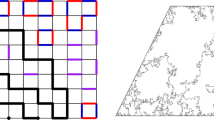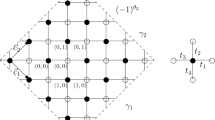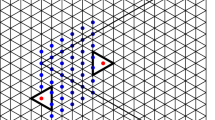Abstract
The dimer model on a planar bipartite graph can be viewed as a random surface measure. We study these fluctuations for a dimer model on the square grid with two different classes of weights and provide a condition for their equivalence. In the thermodynamic limit and scaling window, these height fluctuations are shown to be non-Gaussian.









Similar content being viewed by others
References
Bauer, M., Bernard, D., Kytölä, K.: LERW as an example of off-critical SLEs. J. Stat. Phys. 132(4), 721–754 (2008)
Benjamini, I., Lyons, R., Peres, Y., Schramm, O.: Uniform spanning forests. Ann. Probab. 29(1), 1–65 (2001)
Brydges, D.C., Fröhlich, J., Sokal, A.D.: The random-walk representation of classical spin systems and correlation inequalities. II. The skeleton inequalities. Commun. Math. Phys. 91(1), 117–139 (1983)
Camia, F., Joosten, M., Meester, R.: Trivial, critical and near-critical scaling limits of two-dimensional percolation. J. Stat. Phys. 137(1), 57–69 (2009)
Funaki, T.: Stochastic interface models. In: Lectures on Probability Theory and Statistics. Lecture Notes in Math., vol. 1869, pp. 103–274. Springer, Berlin (2005)
Kasteleyn, P.W.: The statistics of dimers on a lattice: I. the number of dimer arrangements on a quadratic lattice. Physica 27, 1209–1225 (1961)
Kenyon, R.: Local statistics of lattice dimers. Ann. Inst. Henri Poincaré Probab. Stat. 33(5), 591–618 (1997)
Kenyon, R.: Conformal invariance of domino tiling. Ann. Probab. 28(2), 759–795 (2000)
Kenyon, R.: Long-range properties of spanning trees. J. Math. Phys. 41(3), 1338–1363 (2000)
Kenyon, R.: Dominos and the Gaussian free field. Ann. Probab. 29(3), 1128–1137 (2001)
Kenyon, R.: Lectures on dimers. In: Statistical Mechanics. IAS/Park City Math. Ser., vol. 16, pp. 191–230. Am. Math. Soc., Providence (2009)
Kenyon, R.W., Propp, J.G., Wilson, D.B.: Trees and matchings. Electron. J. Comb. 7, Research Paper 25, 34 pp. (2000) (electronic)
Kenyon, R., Okounkov, A., Sheffield, S.: Dimers and amoebae. Ann. Math. (2) 163(3), 1019–1056 (2006)
Lashkevich, M.: Scaling limit of the six-vertex model in the framework of free field representation. J. High Energy Phys. 10, Paper 3, 18 pp. (1997) (electronic)
Lawler, G.F.: Conformally Invariant Processes in the Plane. Mathematical Surveys and Monographs, vol. 114. Am. Math. Soc., Providence (2005)
Lukyanov, S.: Form factors of exponential fields in the sine-Gordon model. Mod. Phys. Lett. A 12(33), 2543–2550 (1997)
Makarov, N., Smirnov, S.: Off-critical Lattice Models and Massive SLEs (2009). doi:10.1142/9789814304634_0024
Nolin, P., Werner, W.: Asymmetry of near-critical percolation interfaces. J. Am. Math. Soc. 22(3), 797–819 (2009)
Schramm, O.: Scaling limits of loop-erased random walks and uniform spanning trees. Isr. J. Math. 118, 221–288 (2000)
Schramm, O., Sheffield, S.: Contour lines of the two-dimensional discrete Gaussian free field. Acta Math. 202(1), 21–137 (2009)
Sheffield, S.: Random surfaces. Astérisque 304, vi+175 (2005)
Sheffield, S.: Gaussian free fields for mathematicians. Probab. Theory Relat. Fields 139(3–4), 521–541 (2007)
Wendelin, W.: Random Planar Curves and Schramm-Loewner Evolutions. Lecture Notes in Math., vol. 1840. Springer, Berlin (2004)
Wilson, D.B.: Generating random spanning trees more quickly than the cover time. In: Proceedings of the Twenty-Eighth Annual ACM Symposium on the Theory of Computing, Philadelphia, PA, 1996, pp. 296–303. ACM, New York (1996)
Acknowledgements
I would like to particularly thank Richard Kenyon for the many fruitful discussions which have led to this paper. I would also like to thank David Brydges for discussions of statistical mechanical models, Scott Sheffield for some very useful suggestions, Cédric Boutillier, Benjamin Young and Adrien Kassel for very many useful comments on this paper. Supported/Partially supported by the grant KAW 2010.0063 from the Knut and Alice Wallenberg Foundation.
Author information
Authors and Affiliations
Corresponding author
Appendix
Appendix
In Appendix, we present the function from Lemma 4.5. For y 1=x 2−x 1, y 2=x 3−x 2 and y 3=x 4−x 3, we have

We also have the following lemma which is based on a crude argument.
Lemma A.1
There exists γ 1,…,γ 4, so that

Proof
To show that \(\int_{\gamma_{1}} \dots\int_{\gamma_{4}}f_{\lambda _{1},\lambda _{2}}(x_{1},x_{2},x_{3},x_{4}) dx_{4} \dots dx_{1}\neq0\) for some choice of intervals γ i , choose γ 1=(0,1/2n), γ 2=(1−1/2n,1), γ 3=(2,2+1/2n) and γ 4=(3,3−1/2n). We claim that \(f_{\lambda _{1},\lambda _{2}}(x_{1},x_{2},x_{3},x_{4})\) is positive over this interval and so the integral over γ 1,…,γ 4 is non-zero.
We can bound y 1 and y 3 in terms of y 2 where y 1,y 2 and y 3 are defined above. These are given by

and

We can separate (A.1) into positive terms and negative terms, i.e. we can write (A.1) as g +(y 1,y 2,y 3)−g −(y 1,y 2,y 3) where g − and g + are positive. A lower bound for the positive terms can be achieved by setting y 1 and y 3 to y 2. An upper bound of the absolute value of the negative terms can be achieved by setting y 1 and y 3 to y 2(2n−2)/(2n+2). In other words, we have

and

The difference between these two bounds is positive provided we take n=|λ|m for |λ|≥1 and n=m/|λ| for |λ|<1 where m>20 (these bounds are not tight).
Indeed, by setting (2n−2)/(2n+2)=1−x, we can take a series expansion with respect to x between the positive and negative terms, which is given by

where the derivative is with respect to x. The x 0 term is strictly positive and is bounded below by \(e^{- 12 y_{2} |\lambda|}\). This is due to comparing the following positive and negative terms of (A.1) and noting that the difference in each case is bounded below by \(e^{- 12 y_{2} |\lambda|}\). These differences are given explicitly by




For |λ|≥1, the coefficient of the x 1 term in the above series expansion is negative and its absolute value is bounded above by \(e^{-|\lambda| y_{2}}\) for y 2≥1. As x is smaller than 1/220γ, then \(f_{\lambda_{1}, \lambda_{2}}(x_{1},x_{2},x_{3},x_{4})\) is positive over γ 1,…,γ 4 for |λ|≥1. For 0<|λ|<1, the absolute value of the coefficient of x 1 is bounded above by some constant c>2 for y 2≥1. As 1/220γ is less than \(e^{-12 y_{2} \gamma}\), the order x 1 term is less than the order x 0 term. This means \(f_{\lambda_{1}, \lambda_{2}}(x_{1},x_{2},x_{3},x_{4})>0\) over γ 1,…,γ 4. □
Rights and permissions
About this article
Cite this article
Chhita, S. The Height Fluctuations of an Off-Critical Dimer Model on the Square Grid. J Stat Phys 148, 67–88 (2012). https://doi.org/10.1007/s10955-012-0529-3
Received:
Accepted:
Published:
Issue Date:
DOI: https://doi.org/10.1007/s10955-012-0529-3




